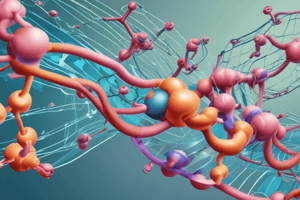Podcast
Questions and Answers
Which of the following is correct about Edman degradation?
Which of the following is correct about Edman degradation?
- Treatment of protein at pH = 3 with PITC
- Treatment with anhydrous acid results in cleavage of the C-terminal residue.
- Edman degradation is required to determine the sequence of protein. (correct)
- All of the above.
Which of the following statement is correct about fibrous proteins?
Which of the following statement is correct about fibrous proteins?
- Fibrous proteins have 3º structure
- Fibrous proteins are soluble
- Fibrous proteins only have 2º structure (correct)
- Fibrous proteins carry out metabolic functions
Which of the following statement is NOT correct about Loops?
Which of the following statement is NOT correct about Loops?
- Loops contribute to secondary structure
- Loops can be quite long and “disordered”
- Loops are held together by hydrogen bonding (correct)
- Loops often contain hydrophilic residues
Which of the following is Globular protein?
Which of the following is Globular protein?
Which of the following is correct about β-Strands and β-Sheets?
Which of the following is correct about β-Strands and β-Sheets?
The rise, pitch and the number of residues per turn of α-helix are
The rise, pitch and the number of residues per turn of α-helix are
In α-helix, C=O hydrogen-bonded to each ____ H-N on backbone
In α-helix, C=O hydrogen-bonded to each ____ H-N on backbone
Which of the following chromatography should be used to separate proteins on the charge?
Which of the following chromatography should be used to separate proteins on the charge?
Which of the following interaction maintains the protein secondary structure?
Which of the following interaction maintains the protein secondary structure?
Which of the following is correct about turns?
Which of the following is correct about turns?
What is the mobile phase for size exclusion chromatography?
What is the mobile phase for size exclusion chromatography?
Which of the following residues is the most common in α-Helices?
Which of the following residues is the most common in α-Helices?
Which of the following is the subtype(s) of Mass spectrometry according to the ion source?
Which of the following is the subtype(s) of Mass spectrometry according to the ion source?
SDS-PAGE is separating molecules according to_______.
SDS-PAGE is separating molecules according to_______.
During size exclusion (gel filtration) chromatography, __________ proteins are eluted in the earlier fraction
During size exclusion (gel filtration) chromatography, __________ proteins are eluted in the earlier fraction
Which of the following statement is correct about domains?
Which of the following statement is correct about domains?
Which of the following solution will disrupt the hydrogen bonding in tertiary structure?
Which of the following solution will disrupt the hydrogen bonding in tertiary structure?
Which of the following is correct about Lectin Affinity Chromatography?
Which of the following is correct about Lectin Affinity Chromatography?
Which of the following statement is correct about SDS-PAGE?
Which of the following statement is correct about SDS-PAGE?
Flashcards are hidden until you start studying
Study Notes
Protein Structure and Chromatography
- Edman degradation is a method to determine the N-terminal amino acid of a protein.
- Fibrous proteins are composed of long, thin molecules and are often involved in structural or mechanical roles.
- Loops are regions of protein structures that do not form α-helices or β-sheets and are often found on the surface of proteins.
- Globular proteins are compact, roughly spherical molecules and are often involved in metabolic processes.
Protein Secondary Structure
- β-Strands are extended protein structures that are often found in β-sheets, which are composed of multiple β-strands held together by hydrogen bonds.
- α-Helices are spiral-shaped protein structures that are stabilized by hydrogen bonds between the C=O and H-N groups of the backbone, with 3.6 amino acids per turn.
Chromatography
- Ion-exchange chromatography is used to separate proteins based on their charge.
- Hydrogen bonds, ionic bonds, disulfide bonds, and hydrophobic interactions maintain protein secondary structure.
- Size exclusion chromatography uses a mobile phase of buffer and separates molecules based on their size.
Protein Analysis
- Turns are a type of non-repetitive secondary structure and are often involved in protein-protein interactions.
- Glutamic acid is the most common residue found in α-helices.
- Matrix-assisted laser desorption/ionization (MALDI) and electrospray ionization (ESI) are subtypes of mass spectrometry.
- SDS-PAGE separates molecules based on their size.
Protein Interactions and Purification
- Domains are independently folded regions of a protein that are often involved in specific functions.
- Urea is a solution that can disrupt the hydrogen bonding in tertiary structure.
- Lectin affinity chromatography is a type of affinity chromatography that uses lectins to purify proteins based on their carbohydrate content.
- In size exclusion chromatography, larger proteins are eluted in the earlier fraction.
Studying That Suits You
Use AI to generate personalized quizzes and flashcards to suit your learning preferences.


